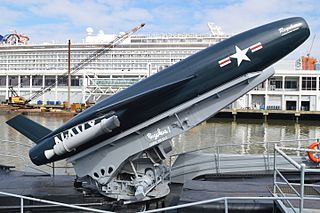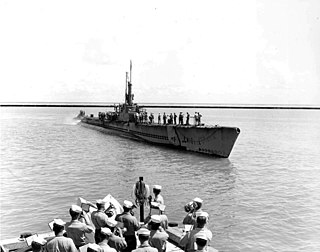
The SSM-N-8A Regulus or the Regulus I was a United States Navy-developed ship-and-submarine-launched, nuclear-capable turbojet-powered second generation cruise missile, deployed from 1955 to 1964. Its development was an outgrowth of U.S. Navy tests conducted with the German V-1 missile at Naval Air Station Point Mugu in California. Its barrel-shaped fuselage resembled that of numerous fighter aircraft designs of the era, but without a cockpit. Test articles of the Regulus were equipped with landing gear and could take off and land like an airplane. When the missiles were deployed they were launched from a rail launcher, and equipped with a pair of Aerojet JATO bottles on the aft end of the fuselage.

The George Washington class was a class of nuclear-powered ballistic missile submarines deployed by the United States Navy. George Washington, along with the later Ethan Allen, Lafayette, James Madison, and Benjamin Franklin classes, comprised the "41 for Freedom" group of submarines that represented the Navy's main contribution to the nuclear deterrent force through the late 1980s.

USS Bonefish (SS-223) was a Gato-class submarine, the first United States Navy ship to be named for the bonefish.

USS Halibut (SSGN-587), a unique nuclear-powered guided missile submarine-turned-special operations platform, later redesignated as an attack submarine SSN-587, was the second ship of the United States Navy to be named after the halibut.
USS Barbel (SS-316), a Balao-class submarine, was the first ship of the United States Navy to be named for the barbel, a fish commonly called a minnow or carp.

USS Bowfin (SS/AGSS-287), is a Balao-class submarine of the United States Navy named for the bowfin fish. Since 1981, she has been open to public tours at the USS Bowfin Submarine Museum & Park in Pearl Harbor, Hawaii, next to the USS Arizona Memorial Visitor Center.

USS Robalo (SS-273), a Gato-class submarine, was the only ship of the United States Navy to be named for the róbalo or common snook.

USS Flier (SS-250) was a Gato-class submarine, was the only ship of the United States Navy to be named for the flier.

USS Salmon (SS-182) was the lead ship of her class of submarine. She was the second ship of the United States Navy to be named for the salmon.

USS Bluefish (SS-222), a Gato-class submarine, was the first ship of the United States Navy to be named for the bluefish. Between 9 September 1943 and 29 July 1945 she completed nine war patrols. Her operating area extended from the Netherlands East Indies to the waters south of Honshū. According to the notoriously unreliable JANAC accounting, Bluefish sank 12 Japanese ships totaling 50,839 tons.

USS Hoe (SS-258), a Gato-class submarine, was a ship of the United States Navy named for the hoe, one of various sharks, especially the dogfish.

USS Puffer (SS-268), a Gato-class submarine, was the first ship of the United States Navy to be named for the puffer.

USS Redfin (SS/SSR/AGSS-272), a Gato-class submarine, was a ship of the United States Navy named for the redfin, any of several North American fishes with reddish fins.

USS Cabrilla (SS/AGSS-288), a Balao-class submarine, was a ship of the United States Navy named for the cabrilla, an edible fish inhabiting the Mediterranean Sea and waters off the coast of California.

USS Becuna (SS/AGSS-319), a Balao-class submarine in commission from 1944 to 1969, was a submarine of the United States Navy named for the becuna, a pike-like fish of Europe. During World War II, she conducted five war patrols between August 23, 1944 and July 27, 1945, operating in the Philippine Islands, South China Sea, and Java Sea. She is credited with sinking two Japanese tankers totaling 3,888 gross register tons.

USS Besugo, a Balao-class submarine, was a ship of the United States Navy in commission from 1944 to 1958. She was named for the besugo.

USS Brill (SS-330), a Balao-class submarine, was a ship of the United States Navy in commission from 1944 to 1947. She was named for the brill, a European flatfish.

USS Guitarro (SS-363), a Gato-class submarine, was the first ship of the United States Navy to be named for the guitarro.

USS Icefish (SS-367), a Balao-class submarine, was a ship of the United States Navy named for the icefish, any member of the family Salangidae, small smeltlike fishes of China and Japan. These fish are also collectively known as whitebait.

The Regulus missile submarines were a group of submarines operated by the United States Navy capable of carrying the Regulus cruise missile. Between 1959 and 1964, a total of five boats were used to undertake the first submarine-based nuclear deterrent patrols by the United States. Regulus submarines were used for this task until 1964, when sufficient ballistic missile submarines carrying the Polaris ballistic missile became available.




















